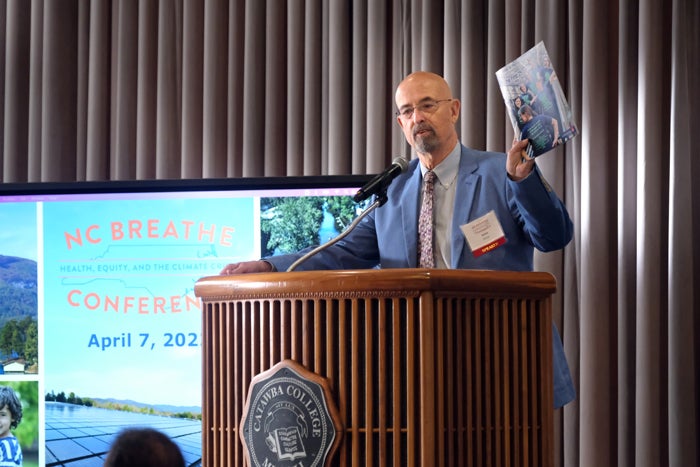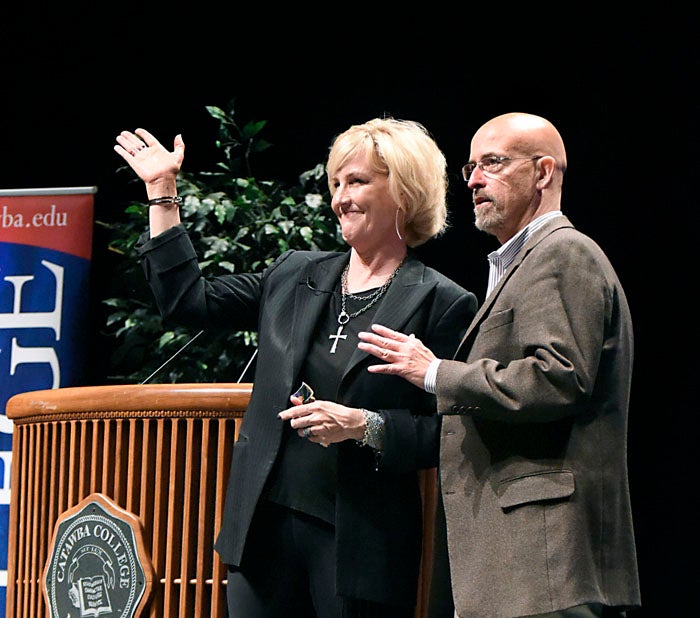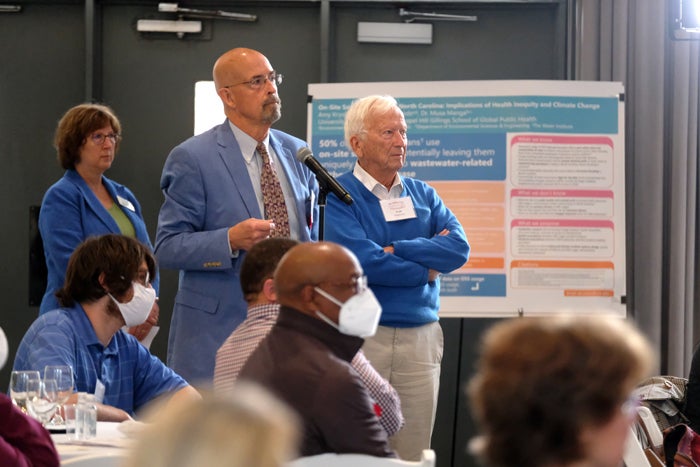Wear to step down from Center for Environment
Published 12:05 am Sunday, July 3, 2022
SALISBURY — Dr. John Wear, the founding director of the Center for the Environment at Catawba College, is stepping down at the end of July as the head of one of the premier environmental centers in the nation.
He will continue to teach as well as tackle new initiatives. In addition, he plans to write about the center’s approach to advancing sustainability. “There is a lot I have learned and experienced along the way that I would like to share with leaders across the nation who are attempting to educate their own communities,” he says.
Catawba College President David Nelson expressed his appreciation for Wear’s leadership and hard work throughout his tenure as the center’s director. “John has led the Center for the Environment now for a generation,” he said. “We owe him a debt of gratitude for building the center from its foundation and growing it into the national resource it is today, addressing the central issues of our day. Dr. Wear has done his work with great care, and we are deeply grateful to him.”
Several nationally known environmental leaders recently shared their thoughts about Wear, a man once named a Charlotte Observer “Guardian of the Earth” who has received numerous awards and honors for his leadership and engagement in efforts that have spanned a broad range of areas.
Heather White, author and the founder and CEO of OneGreenThing in Bozeman, Montana, captures the traits that earned Wear this respect: “John is able to break down silos in science, policy and education,” she says. “His unique ability to engage people with solutions to complex environmental problems in a way that is honest, creative and also hopeful makes him a truly outstanding environmental educator.
“His keen intelligence, dogged determination and innate kindness distinguish him as a pillar of the national environmental community,” White says. “Working with and getting to know John and the talented team he assembled at the Center for the Environment has been a professional and personal highlight for me.“
Ken Cook, president and co-founder of the Environmental Working Group in Washington, D.C., one of the nation’s largest environmental organizations, speaks to Wear’s abilities as an environmental leader. “Among John’s many talents, I’d have to call out the entrepreneurial spirit that has made him a national leader at the interface of environmental education and policy,” he says. “He is a truly remarkable risk-taker, innovator and educator.”
Center gave Catawba a voice at national level
Under Wear’s leadership, the Center for the Environment has given Catawba College a unique voice at the national level. Julian Keniry, author and co-creator of the National Wildlife Foundation’s Campus Ecology Program, recently called the center “incomparable.” No other center in the country has, in her words, “the approach, the perspective, the longevity and the outcomes” that the Center for the Environment has.
“With leadership from John Wear and his team, the Center for Environment at Catawba College has set many local and national precedents,” she says.
Catawba students have benefitted in many ways from their association with the center under Wear’s guidance. A strong advocate of giving students opportunities to learn outside the classroom, Wear has engaged students in all aspects of the center’s work. He is known for giving them opportunities to develop valuable skills in collaboration, communication and leadership. One of his former students called Wear’s approach “education for the real world.”
The recently published 25th anniversary magazine entitled “The First 25 Years,” which can be found at https://catawba.edu/cenv25mag, fleshes out the history of the center and the many people who engaged with causes the center championed during the more than quarter century Wear has served as director.
One overarching goal governed decisions
As Wear looks back over the center’s nearly 26-year history, he notes that one overarching goal stood at the forefront of almost every decision. That goal was rooted in events that occurred in the years before 1993 when he began teaching at Catawba.
“The 1980s saw some major paradigm shifts that ultimately influenced my thinking,” he says. “A group of individuals primarily in Sweden — some of whom I continue to collaborate with on a new initiative — were working to shift their communities into what they called eco-municipalities. These communities were focused on becoming more sustainable.”
Wear notes that the word sustainability as it is used today didn’t begin to evolve until the 1980s. “It received little conceptualization in the academic literature prior to the 1987 publication in the Brundtland Report in which they defined sustainable development,” he says.
The creation of those eco-municipalities in Sweden catalyzed discussions at what was at that time the world’s largest conference ever: the 1992 World Conference on Environment and Development in Rio de Janeiro.
“A central theme that came out of the conference was the recognition that it was at the community level that changes would need to be made if we were to solve the growing environmental crisis about which world leaders and futurists were becoming aware,” he says.
“That conclusion came about for good reason. The local level of governance is the level that is closest to the people and the level where economic, societal and environmental infrastructure are developed, created, managed and maintained. It is the level that oversees planning, establishes local environmental policies and regulations, and assists in implementing national and state environmental policies. It is a critically important level if we wish to truly shift communities in ways that help solve the urgent and accelerating environmental crisis we now face.”
Wear’s focus was at the local level
When Wear came to Catawba in 1993, he immediately became deeply involved in all manner of local, regional, and statewide initiatives and looked at ways to engage his students in hands-on learning.
“One important fact that I learned along the way was that for elected leaders to make substantial changes in their communities, especially concerning the environment and sustainability, the citizens those elected leaders serve have to actually understand the importance of the actions that need to take place and be willing to support and vocalize support for those actions.
His question became, “Could this small private liberal arts college act as a nexus to convene the various players in ways that would truly have an impact on communities in this region, the state and beyond?”
From the time he arrived at Catawba until 1996, he spent a lot of time conceptualizing how this might be best approached. “In 1996, when I went to President Fred Corriher with the idea for the creation of the Center for the Environment, it was not to simply create an entity that did outreach; it was much, much more,” he says.
“It was to demonstrate how a center that is part of a small college could effectively educate the citizens in its local community and in communities in the surrounding region to facilitate the shifts that are needed to move communities towards more sustainable behavior and action.”
Center’s outreach mirrored the issues of the time
One thing that has made the center’s outreach unique, according to Wear, is its ability to mirror the issues and shifts in thinking as they emerged over time. “We not only brought attention to that issue, but we took it much further, engaging in multiple, creative ways that directly involved us and allowed us to better understand and respond to that moment.
“While most people think about the speakers we brought to campus when they think about the center, it was really the major initiatives that were the focus of most of our work,” Wear says. “Our major initiatives also brought me directly into touch with those people across the region, the state and often the nation, which helped us in many ways but primarily in identifying what was important as well as what solutions exist.
“In every case we developed educational strategies, focused on outreach to multiple segments of the population, convened people, facilitated discussions and provided workshops,” he says.
Those bigger initiatives were responses to the needs and shifts in thinking at the time and encompassed many areas including sustainable development, watershed and river protection, land conservation efforts, green building, air quality improvement, faith and environmental stewardship outreach, community solar education, youth education, school outreach and more.
ln addition, all the initiatives relied on partnerships. “Creating collaborative partnerships has allowed us to achieve things that as a single entity we could never have accomplished, and they all created an exciting synergy that makes things happen where the whole really does become greater than the sum of its parts,” he says.
Throughout his tenure as director, Wear engaged in a very broad range of initiatives, including serving on the executive committee of one of the first regional planning efforts to focus on development and environment in this region; working with county leaders to create and ultimately co-chair the state’s first county-endorsed Sustainable Community Development Commission; providing oversight of one of the first green academic buildings in the Southeast; creating a grassroots greenway committee in partnership with the City of Salisbury that initiated its greenway.
Also, taking a leadership role in the creation of an annual statewide watershed conference and coalition during a time when few riverkeeper organizations had yet been established; providing oversight for the center’s Campaign for Clean Air; providing thought leadership and serving on the National Advisory Board for the creation of the America’s first national TV series advocating sustainable living, “Simple Living with Wanda Urbanska”; providing leadership in the creation and oversight for the center’s National Summit for High School Students as well as oversight for its N.C. Green Schools program.
Throughout it all, Wear has maintained a steadfast commitment to the environment, his students, his community and the region. “It has truly been a privilege to work with such inspiring environmental thought leaders from across the country, to help educate the public about the persistent environmental challenges we face, and to facilitate positive change in the region,” he says.
“Of most importance to me personally has been the privilege of working closely with hundreds of young people who care deeply about the environment, who are willing to do what it takes to protect the earth and its resources and who will be active participants in re-designing our future.”
Catawba College is working with Storbeck Search (http://www.storbecksearch.com) on a national search to identify the center’s next executive director. Nominations and applications can be directed to CatawbaEDcenterforenv@storbecksearch.com
• • •
The Center for the Environment at Catawba College was founded in 1996 to provide education and outreach centered on prevalent environmental challenges and to foster community-oriented sustainable solutions that can serve as a model for programs throughout the country.







